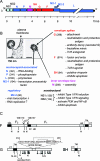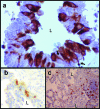Viral and host factors in human respiratory syncytial virus pathogenesis
- PMID: 17928346
- PMCID: PMC2258918
- DOI: 10.1128/JVI.01625-07
Viral and host factors in human respiratory syncytial virus pathogenesis
Figures



References
-
- Abu-Harb, M., F. Bell, A. Finn, W. H. Rao, L. Nixon, D. Shale, and M. L. Everard. 1999. IL-8 and neutrophil elastase levels in the respiratory tract of infants with RSV bronchiolitis. Eur. Respir. J. 14139-143. - PubMed
-
- Adkins, B., C. Leclerc, and S. Marshall-Clarke. 2004. Neonatal adaptive immunity comes of age. Nat. Rev. Immunol. 4553-564. - PubMed
-
- Akira, S., S. Uematsu, and O. Takeuchi. 2006. Pathogen recognition and innate immunity. Cell 124783-801. - PubMed
-
- Amanatidou, V., G. Sourvinos, S. Apostolakis, A. Tsilimigaki, and D. A. Spandidos. 2006. T280M variation of the CX3C receptor gene is associated with increased risk for severe respiratory syncytial virus bronchiolitis. Pediatr. Infect. Dis. J. 25410-414. - PubMed
-
- Arnold, R., B. Konig, H. Werchau, and W. Konig. 2004. Respiratory syncytial virus deficient in soluble G protein induced an increased proinflammatory response in human lung epithelial cells. Virology 330384-397. - PubMed
Publication types
MeSH terms
Grants and funding
LinkOut - more resources
Full Text Sources
Other Literature Sources
Medical

